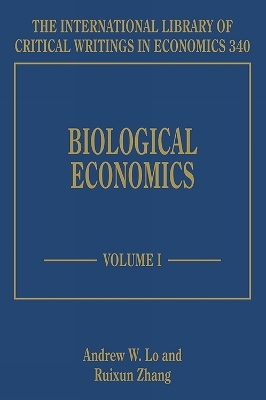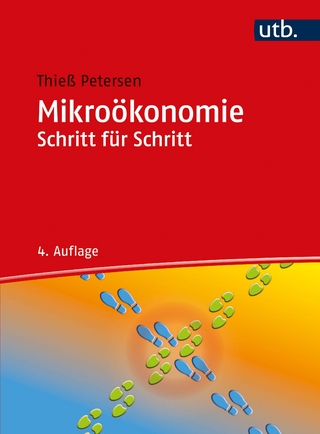
Biological Economics
Edward Elgar Publishing Ltd (Verlag)
978-1-78254-853-9 (ISBN)
>This research review discusses and analyses a unique collection of key publications at the intersection of biology and economics, two disciplines that share a common subject: Homo sapiens. Beginning with Thomas Malthus - whose dire predictions of mass starvation due to population growth influenced Charles Darwin - economists have routinely used biological arguments in their models and methods. The review summarizes the most important of these developments in areas such as sociobiology, evolutionary psychology, behavioral ecology, behavioral economics and finance, neuroeconomics, and behavioral genomics. This research review will be an indispensable tool for economists, biologists, and practitioners looking to develop a deeper understanding of the limits of Homo economicus.
Edited by Andrew W. Lo, Charles E. and Susan T. Harris Professor, MIT Sloan School of Management and Director, MIT Laboratory for Financial Engineering and Ruixun Zhang, MIT Laboratory for Financial Engineering, US
Contents:
Volume I
Acknowledgements
IntroductionAndrew W. Lo and Ruixun Zhang
PART I FOUNDATIONS
1. Rev. T. R. Malthus (1830), ‘On Population’, in A Summary View of the Principle of Population, London, UK: John Murray, i, 1–77
2. Joseph A. Schumpeter (1947), ‘The Creative Response in Economic History’, Journal of Economic History, VII (2), November, 149–59
3. Armen A. Alchian (1950), ‘Uncertainty, Evolution, and Economic Theory’, Journal of Political Economy, 58 (3), June, 211–21
4. J. Hirshleifer (1977), ‘Economics from a Biological Viewpoint’, Journal of Law and Economics, 20 (1), April, 1–52
5. Richard R. Nelson (1995), ‘Recent Evolutionary Theorizing About Economic Change ’, Journal of Economic Literature, XXXIII (1), March, 48–90
PART II SOCIOBIOLOGY
6. W. D. Hamilton (1964), ‘The Genetical Evolution of Social Behaviour I and II’, Journal of Theoretical Biology, 7 (1), July, 1–16, 17–52
7. Robert L. Trivers (1971), ‘The Evolution of Reciprocal Altruism’, Quarterly Review of Biology, 46 (1), March, 35–57[23]
8. Richard D. Alexander (1974), ‘The Evolution of Social Behavior’, Annual Review of Ecology and Systematics, 5, November, 325–83
9. David Sloan Wilson and Elliott Sober (1994), ‘Reintroducing Group Selection to the Human Behavioral Sciences’, Behavioral and Brain Sciences, 17 (4), December, 585–608, references
10. Herbert Gintis, Samuel Bowles, Robert Boyd and Ernst Fehr (2003), ‘Explaining Altruistic Behavior in Humans’, Evolution and Human Behavior, 24 (3), May, 153–72
11. Joseph Henrich (2004), ‘Cultural Group Selection, Coevolutionary Processes and Large-Scale Cooperation’, Journal of Economic Behavior and Organization: Evolution and Altruism, 53 (1), January, 3–35
12. Martin A. Nowak (2006), ‘Five Rules for the Evolution of Cooperation’, Science, 314 (5805), December, 1560–63
13. David Sloan Wilson and Edward O. Wilson (2007), ‘Rethinking the Theoretical Foundation of Sociobiology’, Quarterly Review of Biology, 82 (4), December, 327–48
PART III EVOLUTIONARY PSYCHOLOGY AND BEHAVIORAL ECOLOGY
14. Erika R. Behrend, and M. E. Bitterman (1961), ‘Probability-Matching in the Fish’, American Journal of Psychology, 74 (4), December, 542–51
15. R. J. Herrnstein (1961), ‘Relative and Absolute Strength of Response as a Function of Frequency of Reinforcement’, Journal of the Experimental Analysis of Behavior, 4 (3), July, 267–72
16. Colin W. Clark (1973), ‘The Economics of Overexploitation’, Science, 181 (4100), August, 630–34
17. Colin W. Clark and Marc Mangel (1986), ‘The Evolutionary Advantages of Group Foraging’, Theoretical Population Biology, 30 (1), August, 45–75
18. Lawrence D. Harder and Leslie A. Real (1987), ‘Why Are Bumble Bees Risk Averse?’, Ecology, 68 (4), August, 1104–8
19. Leda Cosmides and John Tooby (1994), ‘Better than Rational: Evolutionary Psychology and the Invisible Hand’, American Economic Review: Papers and Proceedings, 84 (2), May, 327–32
20. Herbert Gintis (2007), ‘Review of Adapting Minds: Evolutionary Psychology and the Persistent Quest for Human Nature’, Journal of Bioeconomics, 9 (2), August, 191–9
21. Avraham Be'er, H. P. Zhang, E. -L. Florin, Shelley M. Payne, Eshel Ben-Jacob and Harry L. Swinney (2009), ‘Deadly Competition between Sibling Bacterial Colonies’, Proceedings of the National Academy of Sciences, 106 (2), January, 428–33
22. Kenneth J. Arrow and Simon A. Levin (2009), ‘Intergenerational Resource Transfers with Random Offspring Numbers’, Proceedings of the National Academy of Sciences, 106 (33), August, 13702–6
23. Thomas J. Brennan and Andrew W. Lo (2011), ‘The Origin of Behavior’, Quarterly Journal of Finance, 1 (1), March, 55–108
PART IVTHE BIOLOGICAL FOUNDATIONS OF UTILITY
24. Ingemar Hansson and Charles Stuart (1990), ‘Malthusian Selection of Preferences’, American Economic Review, 80 (3), June, 529–44
25. Alan R. Rogers (1994), ‘Evolution of Time Preference by Natural Selection’, American Economic Review, 84 (3), June, 460–81
26. Arthur J. Robson (1996), ‘A Biological Basis for Expected and Non-expected Utility’, Journal of Economic Theory, 68 (2), February, 397–424
27. Arthur J. Robson (2001), ‘The Biological Basis of Economic Behavior’, Journal of Economic Literature, XXXIX (1), March, 11–33
28. Rose McDermott, James H. Fowler and Oleg Smirnov (2008), ‘On the Evolutionary Origin of Prospect Theory Preferences’, Journal of Politics, 70 (2), April, 335–50
29. Arthur J. Robson and Larry Samuelson (2009), ‘The Evolution of Time Preference with Aggregate Uncertainty’, American Economic Review, 99 (5), December, 1925–53
30. Ruixun Zhang, Thomas J. Brennan and Andrew W. Lo (2014), ‘The Origin of Risk Aversion’, Proceedings of the National Academy of Sciences, 111 (50), December, 17777–82
PART V RATIONALITY AND INTELLIGENCE
31. Herbert A. Simon (1955), ‘A Behavioral Model of Rational Choice’, Quarterly Journal of Economics, 69 (1), February, 99–118
32. J. Maynard Smith (1984), ‘Game Theory and the Evolution of Behaviour’, Behavioral and Brain Sciences, 7 (1), March, 95–101, references
33. Alan Kirman (1993), ‘Ants, Rationality, and Recruitment’, Quarterly Journal of Economics, 108 (1), February, 137–56
34. Michael Waldman (1994), ‘Systematic Errors and the Theory of Natural Selection’, American Economic Review, 84 (3), June, 482–97
35. Theodore C. Bergstrom (2002), ‘Evolution of Social Behavior: Individual and Group Selection’, Journal of Economic Perspectives, 16 (2), Spring, 67–88
36. Larry Samuelson (2002), ‘Evolution and Game Theory’, Journal of Economic Perspectives, 16 (2), Spring, 47–66
37. Thomas J. Brennan and Andrew W. Lo (2012), ‘An Evolutionary Model of Bounded Rationality and Intelligence’, PLOS ONE, 7 (11), November, 1–8
38. Andrew W. Lo (2013), ‘The Origin of Bounded Rationality and Intelligence’, Proceedings of the American Philosophical Society, 157 (3), September, 269–80
39. Terence C. Burnham (2013), ‘Toward a Neo-Darwinian Synthesis of Neoclassical and Behavioral Economics’, Journal of Economic Behavior and Organization, 90 (Supplement), June, S113–S127
Index
Contents
Volume II
Acknowledgements
Introduction An introduction to both volumes by the editors appears in Volume I
PART I FINANCIAL MARKETS
1. Lawrence Blume and David Easley (1992), ‘Evolution and Market Behavior’, Journal of Economic Theory, 58 (1), October, 9–40
2. J. Doyne Farmer and Andrew W. Lo (1999), ‘Frontiers of Finance: Evolution and Efficient Markets’, Proceedings of the National Academy of Sciences, 96 (18), August, 9991–2
3. J. Doyne Farmer (2002), ‘Market Force, Ecology and Evolution’, Industrial and Corporate Change, 11 (5), November, 895–953
4. Mark J. Kamstra, Lisa A. Kramer and Maurice D. Levi (2003), ‘Winter Blues: A SAD Stock Market Cycle’, American Economic Review, 93 (1), March, 324–43
5. David Hirshleifer and Tyler Shumway (2003), ‘Good Day Sunshine: Stock Returns and the Weather’, Journal of Finance, LVIII (3), June, 1009–32
6. Andrew W. Lo (2004), ‘The Adaptive Markets Hypothesis: Market Efficiency from an Evolutionary Perspective’, Journal of Portfolio Management: 30th Anniversary Issue, 30 (5), 15–29
7. Leonid Kogan, Stephen A. Ross, Jiang Wang and Mark M. Westerfield (2006), ‘The Price Impact and Survival of Irrational Traders’, Journal of Finance, LXI (1), February, 195–229
8. William A. Brock, Cars H. Hommes and Florian O. Wagener (2005), ‘Evolutionary Dynamics in Markets with Many Trader Types’, Journal of Mathematical Economics: Special Issue on Evolutionary Finance, 41 (1–2), February, 7–42
9. Andrew W. Lo, Dmitry V. Repin and Brett N. Steenbarger (2005), ‘Fear and Greed in Financial Markets: A Clinical Study of Day-Traders’, American Economic Review: Papers and Proceedings, 95 (2), May, 352–9
10. George Sugihara, Robert May, Hao Ye, Chih-hao Hsieh, Ethan Deyle, Michael Fogarty and Stephan Munch (2012), ‘Detecting Causality in Complex Ecosystems’, Science, 338 (6106), October, 496–500
11. Andrew W. Lo (2012), ‘Adaptive Markets and the New World Order’, Financial Analysts Journal, 68 (2), March–April, 18–29, Errata
PART II EVOLUTION OF FIRMS AND INSTITUTIONS
12. Sidney G. Winter, Jr. (1964), ‘Economic “Natural Selection” and the Theory of the Firm’, Yale Economic Essays, 4 (1), Spring, 225–72
13. Carsten Herrmann-Pillath (1991), ‘A Darwinian Framework for the Economic Analysis of Institutional Change in History’, Journal of Social and Biological Structures, 14 (2), 127–48
14. Guo Ying Luo (1995), ‘Evolution and Market Competition’, Journal of Economic Theory, 67 (1), October, 223–50
15. Jeroen C. J. M. van den Bergh and John M. Gowdy (2009), ‘A Group Selection Perspective on Economic Behavior, Institutions and Organizations’, Journal of Economic Behavior and Organization, 72 (1), October, 1–20
PART IIINEUROSCIENCE
16. Hans C. Breiter, Itzhak Aharon, Daniel Kahneman, Anders Dale and Peter Shizgal (2001), ‘Functional Imaging of Neural Responses to Expectancy and Experience of Monetary Gains and Losses’, Neuron, 30 (2), May, 619–39
17. Andrew W. Lo and Dmitry V. Repin (2002), ‘The Psychophysiology of Real-Time Financial Risk Processing’, Journal of Cognitive Neuroscience, 14 (3), April, 323–39
18. Camelia M. Kuhnen and Brian Knutson (2005), ‘The Neural Basis of Financial Risk Taking’, Neuron, 47 (5), September, 763–70
19. Benedetto De Martino, Dharshan Kumaran, Ben Seymour and Raymond J. Dolan (2006), ‘Frames, Biases, and Rational Decision-Making in the Human Brain’, Science, 313, (5787), August, 684–7
20. Ernst Fehr and Colin F. Camerer (2007), ‘Social Neuroeconomics: The Neural Circuitry of Social Preferences’, TRENDS in Cognitive Sciences, 11 (10), October, 419–27
21. Sabrina M. Tom, Craig R. Fox, Christopher Trepel and Russell A. Poldrack (2007), ‘The Neural Basis of Loss Aversion in Decision-Making Under Risk’, Science, 315 (5811), January, 515–18
22. Peter Bossaerts (2009), ‘What Decision Neuroscience Teaches Us About Financial Decision Making’, Annual Review of Financial Economics, 1, 383–88, C1–C3, 389–404
23. Ernst Fehr and Antonio Rangel (2011), ‘Neuroeconomic Foundations of Economic Choice – Recent Advances’, Journal of Economic Perspectives, 25 (4), Fall, 3–30
24. Andrew W. Lo (2013), ‘Fear, Greed, and Financial Crises: A Cognitive Neurosciences Perspective’, in Jean-Pierre Fouque and Joseph A. Langsam (eds), Handbook on Systemic Risk, Part VIII, Chapter 23, New York, NY, USA: Cambridge University Press, 622–62
PART IVHORMONES
25. Paul J. Zak, Robert Kurzban and William T. Matzner (2005), ‘Oxytocin is Associated with Human Trustworthiness’, Hormones and Behavior, 48 (5), December, 522–7
26. Terence C. Burnham (2007), ‘High-Testosterone Men Reject Low Ultimatum Game Offers’, Proceedings of the Royal Society B: Biological Sciences, 274 (1623), September, 2327–30
27. Coren L. Apicella, Anna Dreber, Benjamin Campbell, Peter B. Gray, Moshe Hoffman and Anthony C. Little (2008), ‘Testosterone and Financial Risk Preferences’, Evolution and Human Behavior, 29 (6), November, 384–90
28. J. M. Coates and J. Herbert (2008), ‘Endogenous Steroids and Financial Risk Taking on a London Trading Floor’, Proceedings of the National Academy of Sciences, 105 (16), April, 6167–72
29. Benjamin C. Campbell, Anna Dreber, Coren L. Apicella, Dan T. A. Eisenberg, Peter B. Gray, Anthony C. Little, Justin R. Garcia, Richard S. Zamore and J. Koji Lum (2010), ‘Testosterone Exposure, Dopaminergic Reward, and Sensation-Seeking in Young Men’, Physiology and Behavior, 99 (4), March, 451–6
30. Anna Dreber, David G. Rand, Nils Wernerfelt, Justin R. Garcia, Miguel G. Vilar, J. Koji Lum and Richard Zeckhauser (2011), ‘Dopamine and Risk Choices in Different Domains: Findings among Serious Tournament Bridge Players’, Journal of Risk and Uncertainty, 43 (1), August, 19–38
PART VGENOMICS
31. Anna Dreber, Coren L. Apicella, Dan T. A. Eisenberg, Justin R. Garcia, Richard S. Zamore, J. Koji Lum and Benjamin C. Campbell (2009), ‘The 7R Polymorphism in the Dopamine Receptor D4 Gene (DRD4) is Associated with Financial Risk-Taking in Men’, Evolution and Human Behavior, 30 (2), March, 85–92
32. Amir Barnea, Henrik Cronqvist and Stephan Siegel (2010), ‘Nature or Nurture: What Determines Investor Behavior?’, Journal of Financial Economics, 98 (3), December, 583–604
33. David Cesarini, Magnus Johannesson, Paul Lichtenstein, Örjan Sandewall and Björn Wallace (2010), ‘Genetic Variation in Financial Decision-Making’, Journal of Finance, LXV (5), October, 1725–54
34. David Cesarini, Magnus Johannesson, Patrik K. E. Magnusson and Björn Wallace (2012), ‘The Behavioral Genetics of Behavioral Anomalies’, Management Science, 58 (1), January, 21–34
35. Daniel J. Benjamin, David Cesarini, Christopher F. Chabris, Edward L. Glaeser, David I. Laibson, Vilmundur Guđnason, Tamara B. Harris, Lenore J. Launer, Shaun Purcell, Albert Vernon Smith, Magnus Johannesson, Patrik K. E. Magnusson, Jonathan P. Beauchamp, Nicholas A. Christakis, Craig S. Atwood, Benjamin Hebert, Jeremy Freese, Robert M. Hauser, Taissa S. Hauser, Alexander Grankvist, Christina M. Hultman and Paul Lichtenstein (2012), ‘The Promises and Pitfalls of Genoeconomics’, Annual Review of Economics, 4, 627–62, C1
36. Henrik Cronqvist and Stephan Siegel (2014), ‘The Genetics of Investment Biases’, Journal of Financial Economics, 113 (2), August, 215–34
Index
| Erscheinungsdatum | 20.03.2018 |
|---|---|
| Reihe/Serie | The International Library of Critical Writings in Economics series |
| Verlagsort | Cheltenham |
| Sprache | englisch |
| Maße | 169 x 244 mm |
| Themenwelt | Wirtschaft ► Volkswirtschaftslehre ► Mikroökonomie |
| ISBN-10 | 1-78254-853-X / 178254853X |
| ISBN-13 | 978-1-78254-853-9 / 9781782548539 |
| Zustand | Neuware |
| Haben Sie eine Frage zum Produkt? |
aus dem Bereich


